The south is home to plenty of wildlife, including a diverse population of snakes. If you’re planning a trip that involves the outdoors, it can be beneficial to take the time to learn more about the species you may encounter — including the cottonmouths in Alabama.
Cottonmouths, also known as water moccasins, are a common venomous snake in the southern region of the United States. However, they can easily be confused or mistaken for other types of snakes. Interested in learning more about the cottonmouths of Alabama? Let’s dive in!
About Cottonmouths
The scientific name for cottonmouths is Agkistrodon piscivorus. The word for their genus, Agkistrodon, comes from the Greek word ankistron, which means fishhook. This is a possible reference to the hooked fangs of snakes in this genus, which includes cottonmouths as well as copperheads. The species name, piscivorus, is a reference to their fish diet.
Cottonmouths are just one type of venomous snake in Alabama. They have a wide, diverse range from as far north as Virginia to across the southern states. Cottonmouths are able to thrive in these areas due to the humid temperatures and access to water.
Cottonmouths have a widely diverse diet. Since they live in a semi-aquatic environment, they have the opportunity to access many different types of prey. Some of the most common are amphibians like frogs, lizards, toads, turtles, fish, and small mammals. Once they reach their adult size, they’re known to eat other snakes (including smaller cottonmouths!) and even baby alligators.
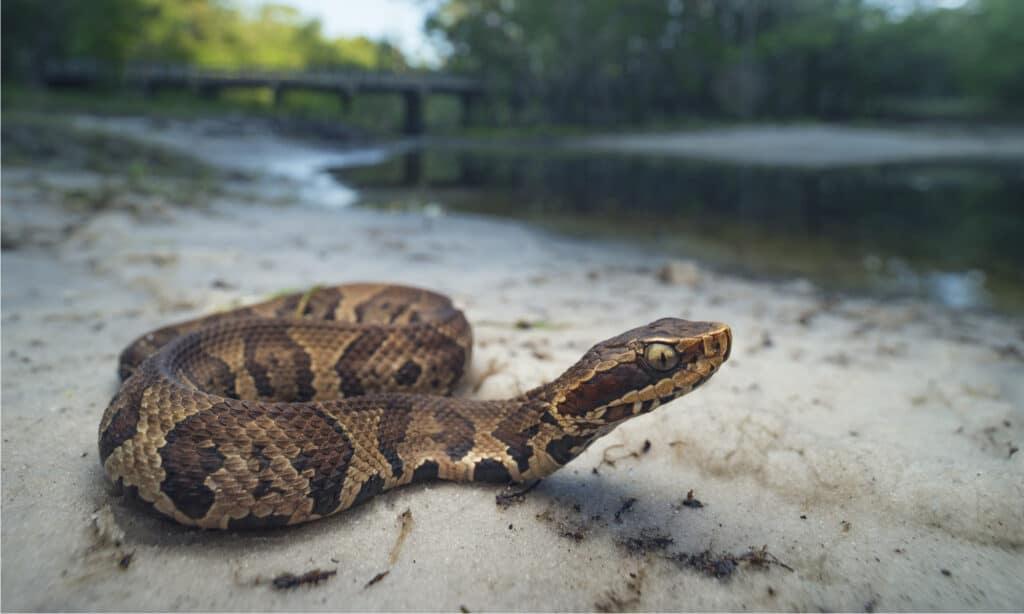
Cottonmouths are semi-aquatic and are also known as water moccasins.
©Kristian Bell/Shutterstock.com
Appearance
At a glance, it can be difficult to identify a cottonmouth. This is because their exterior isn’t unique from many other species of snakes. Cottonmouths tend to come in darker colors, specifically a dark red, and they can have dark brown or black markings. These markings usually don’t have a uniform shape, unlike the copperhead. Cottonmouths are best identified by the inside of their mouth, which is a bright white – like cotton – and is where they get their common name from.
As for their size, cottonmouths are much bigger than your typical garden snake. However, they’re around average when compared to other venomous snakes. The typical size for a cottonmouth is between 2 and 4 feet long. However, the largest cottonmouth was over 6 feet long.
Because of their large size, there aren’t many predators of adult cottonmouths. The most common predators are large birds of prey. However, as snakelets, cottonmouths can fall prey to everything from other snakes to birds. Many animals feed on snake eggs, as well.
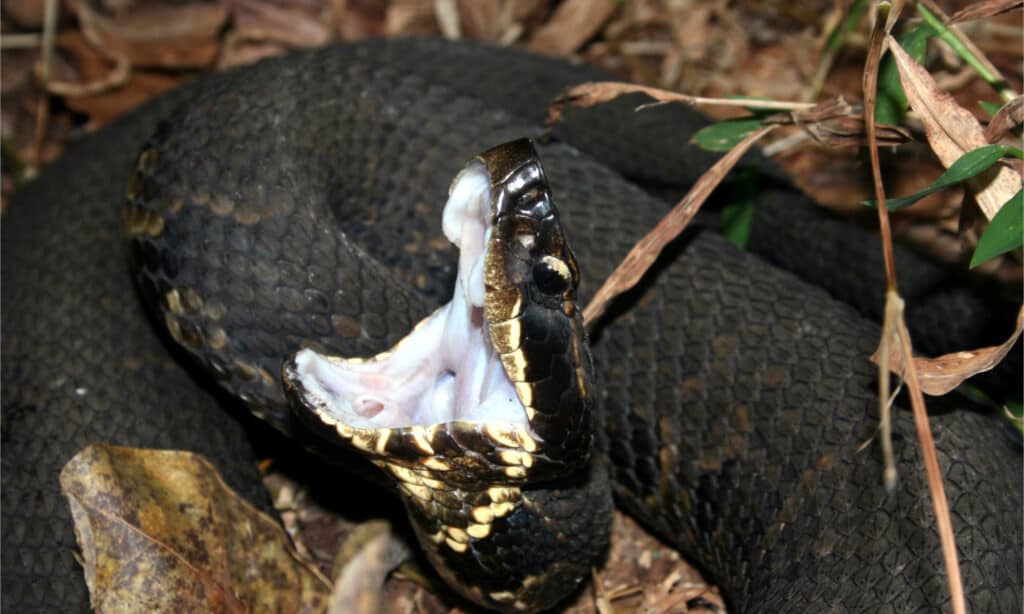
Cottonmouths are easiest to identify by the distinctive white inside their mouth.
©Psychotic Nature/Shutterstock.com
Where Can Cottonmouths Be Found in Alabama?
As a sub-aquatic species, you can find cottonmouths almost everywhere you can find water. Freshwater, that is. Although there are some species of snakes that live near beaches, and even some that live in the ocean itself, cottonmouths aren’t one of them.
Instead, cottonmouths prefer freshwater. Some of their favorite habitats are swamps and similar areas. However, they can also be found around creeks and lakes.
How Often Do Cottonmouths Bite?
As a venomous species, a cottonmouth’s bite is considered one of the most dangerous snake bites. Their venom contains certain toxins and enzymes that can be dangerous, especially in certain people.
However, as dangerous as they are, cottonmouth bites aren’t common. This is because they don’t see us as prey or predator – unless we threaten them. As a result, rather than attempt to bite you, they’d much rather flee during an encounter, or scare you off.
Since their coloration makes it so they blend into the forest floor, however, it can be easy to miss a cottonmouth and accidentally step on them. This is actually one of the main causes of snake bites. They aren’t acting in aggression, they’re just afraid, in pain, and trying to protect themselves.
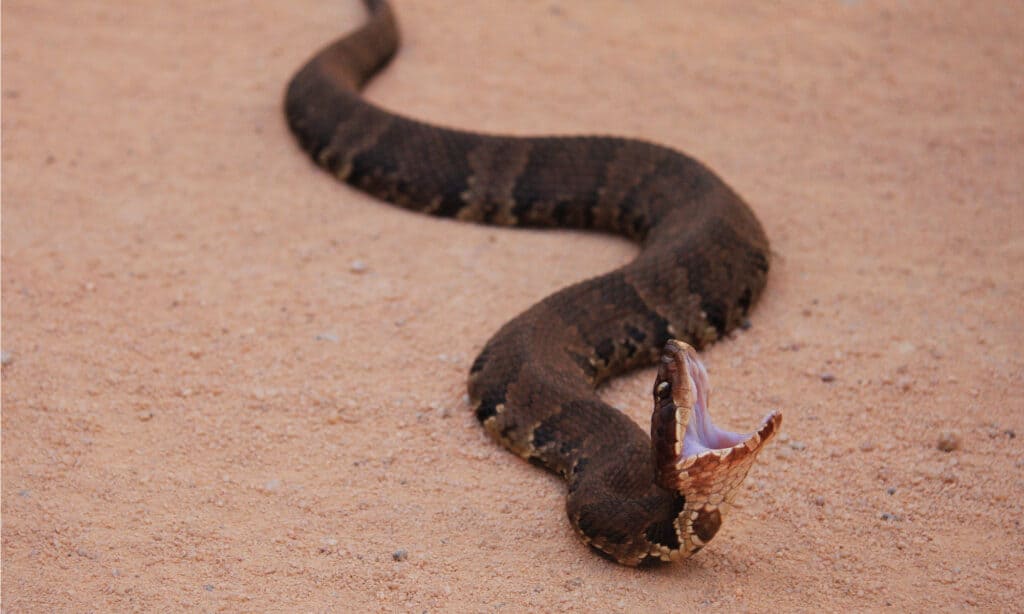
Although extremely venomous, cottonmouths are not typically prone to striking without reason.
©Nathan A Shepard/Shutterstock.com
What to Do About a Venomous Snake Bite?
A venomous snake bite is regarded as an emergency medical situation. This means it is important to seek medical assistance immediately if you happen to be bitten by a cottonmouth or any other type of venomous snake.
Thankfully, venomous snake bites in today’s age are rarely lethal. However, they can be if medical care is delayed. As a result, immediate medical care can be the difference in a life-or-death situation when it comes to a venomous snake, especially one like the cottonmouth.
Even nonvenomous snakes can be dangerous if they are able to puncture this skin. This is because of bacterial infections.
Other Venomous Snakes in Alabama
As a southern state, Alabama is home to a variety of venomous species. In fact, cottonmouths are just one example of the venomous wildlife of this state. Including the cottonmouth, there are six snakes to be aware of in Alabama.
Here’s more information about the other five venomous species to be wary of.
Copperhead
The copperhead (Agkistrodon contortrix) is in the same genus as the cottonmouth. They are also known as the eastern copperhead due to the fact that they’re only found naturally in the eastern region of the United States.
Although they’re related, you actually won’t often find the copperhead near cottonmouths. They both like to live in swampy areas, but the copperhead actually favors certain types of forests. When it comes time to hibernate, however, you will find the copperhead nestled up with other types of snakes such as timber rattlesnakes and black rat snakes.
Copperhead snakes are some of the most common venomous snakes in the eastern part of the United States. However, many people see a copperhead without realizing it. This is because they can be difficult to identity if you’re not sure what you’re looking for – just like with the cottomouths in Alabama. You can tell a copperhead by their distinct copper color. They also have a unique hourglass pattern along their body, usually made up by darker red or brown splotches.
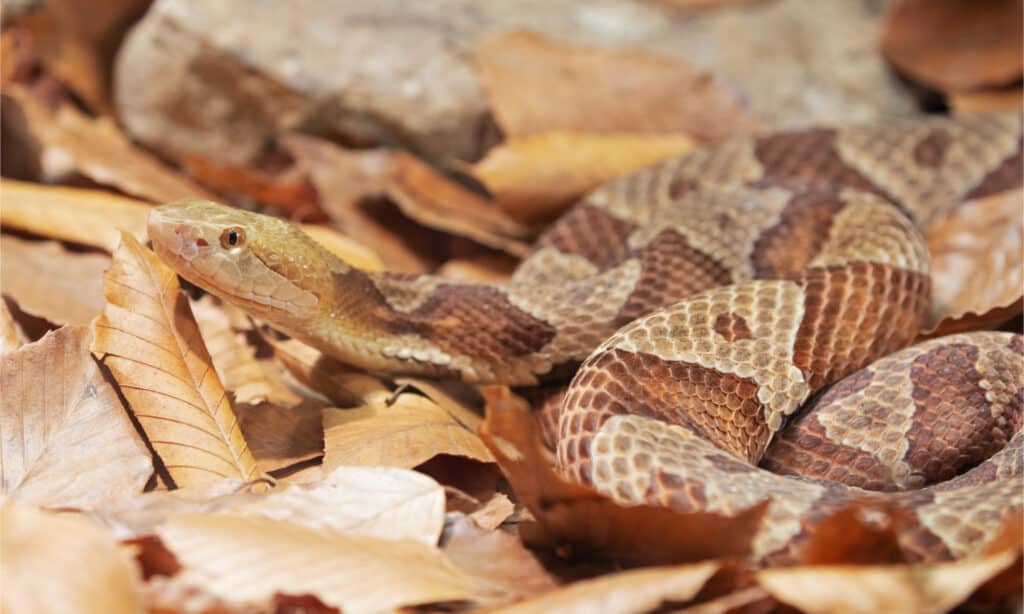
Copperheads are another venomous snake in Alabama.
©DnDavis/Shutterstock.com
Coral Snake
The eastern coral snake is another common but tricky to-identify venomous snake. Known scienfitically as Micrurus fulvius, the eastern coral snake as many different names, including the common coral snake and the American cobra. The latter name comes from the fact that they’re a highly venomous species.
Many different species utilize mimicry to take advantage of this dangerous reputation. Two notable species are the scarlet snake (Cemophora coccinea) and the scarlet kingsnake (Lampropeltis elapsoides).
While it can be confusing to tell this venomous species from nonvenomous species, there’s a rhyme to help: “red on yellow will kill a fellow, red on black will give him some slack.” This refers to the pattern of different colored bands along the snake’s body and which order they’re in. Note it’s important to realize that this isn’t a global rhyme. While it can help tell different states apart in the United States, it may not be the same for tropical snakes or snakes in other regions.
Coral snakes are adaptable and eat a wide variety of prey thanks to their ability to survive in most areas.
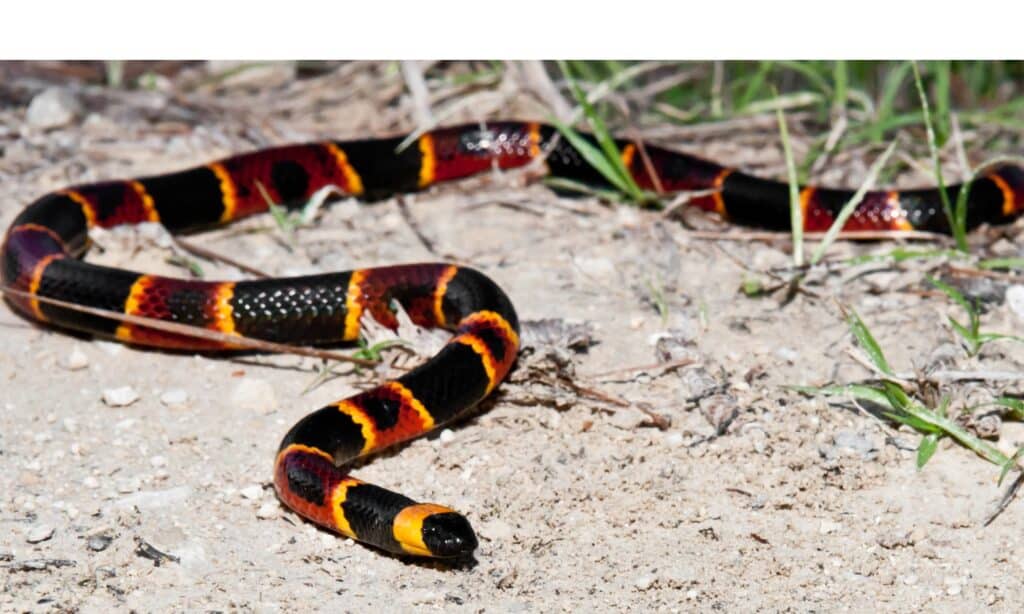
The eastern coral snake is extremely venomous but often confused with kingsnakes.
©iStock.com/JasonOndreicka
Rattlesnakes
Lastly, rattlesnakes are some of the most venomous snakes in all of North America. In fact, one species in Alabama, the eastern diamondback snake, is the most venomous snake on this continent!
There are around 36 species of rattlesnake and up to 70 subspecies. You can find three in Alabama: the pygmy rattlesnake, the timber rattlesnake, and the eastern diamondback snake.
Thankfully, compared to other venomous snakes, rattlesnakes are fairly easy to identify. This is due to their namesake rattler on their tail. Made up of keratin, this important part grows with the snake and helps warn predators away.
The photo featured at the top of this post is © Psychotic Nature/Shutterstock.com
Discover the "Monster" Snake 5X Bigger than an Anaconda
Every day A-Z Animals sends out some of the most incredible facts in the world from our free newsletter. Want to discover the 10 most beautiful snakes in the world, a "snake island" where you're never more than 3 feet from danger, or a "monster" snake 5X larger than an anaconda? Then sign up right now and you'll start receiving our daily newsletter absolutely free.
Sources
- WSFA, Available here: https://www.wsfa.com/story/38169497/slideshow-venomous-snakes-native-to-alabama/
- National Library of Medicine, Available here: https://www.ncbi.nlm.nih.gov/books/NBK546645/
Thank you for reading! Have some feedback for us? Contact the AZ Animals editorial team.






